#portraying sensitive subjects doesn’t equal supporting them
Explore tagged Tumblr posts
Text
i will never forgive the internet for making the phrase “fiction affects reality” inherently suspicious because like fiction absolutely does affect reality in the sense that the themes and messages of media can challenge or affirm people’s biases, it can impact one’s ideology, so much of fiction is commentary on real social issues
and yet! everyone who uses the phrase fiction affects reality is using it as a pro-censorship argument and i simply do not fuck with that
#fiction#media literacy#anti censorship#the media you like isn’t representative of your morals#portraying sensitive subjects doesn’t equal supporting them#censorship is bad actually
8K notes
·
View notes
Text
The Megxit Drama pt. 2
Since I already went through Meghan Markle’s chart in light of the Megxit Drama, I’m going to get into Prince Harry’s as well, considering that they’re both very much part of this demonstrative break with tradition and authority. However, for Harry, it’s not only a break with a work environment and in laws, it’s a break with his family, his up-bringing and his roots in an attempt to rid himself from outdated and harmful beliefs and thought-systems imbedded in fabric of the institution.
As stated in my previous post, Harry and Meghan has been far from applauded in their break with the Royal Family, especially after the Oprah interview in March where they made public accusations of being treated unfairly in various ways. Meghan felt attacked by the media, left out in the cold and denied protection, deprived of support when she felt suicidal and even encountering racism. Aside from Harry’s motivation to help his wife, he admittedly also felt like Meghan’s situation gave him the opportunity to cut ties for good with a way of life that apparently had affected him more negatively and positively throughout his childhood and into his adulthood.
It’s certainly bold for Prince Harry to make complaints seeing as the public tends to not appreciate when wealthy and privileged people come out whining and wimping about their “difficult life”. However, the world is not as straight forward as rich equals happy and poor equals sad. Starvation and difficulty can be encountered on many levels of existence and just because one is born a prince doesn’t mean that one is incapable of experiencing legitimate lack. Life doesn’t spare any of us, which is why there should be compassion for all people – there’s no group or individual that is exclusively entitled to have their suffering be acknowledged. In a sense, Harry being able to look at his own struggles and prioritize his own and his wife’s well-being is a good thing. The message and spirit behind their action is good, at least if they’re honest and genuine (which people still doubt). Regardless, when the status quo is disrupted, there will be friction and unpleasantries.
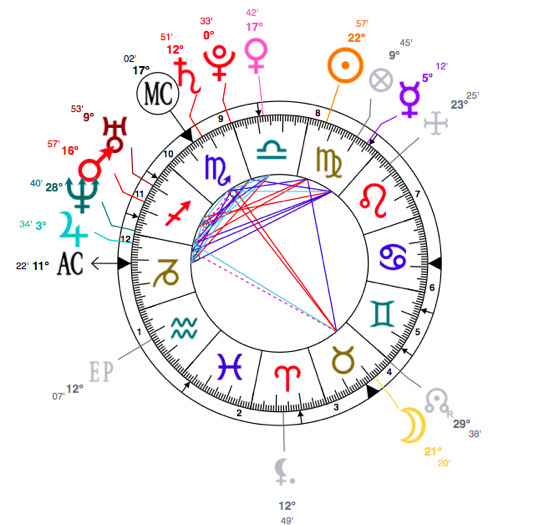
(Chart of Prince Harry on astrotheme.com)
Although Harry’s chart reflects a predominantly earthy influence, which is speaking to the need for structure, permanence and routine, his planets in Sagittarius and Scorpio, gives him a free spirit and emotional endurance. Ever since Harry was little he was notably more impulsive and risk-taking than his brother William. Harry’s Mars (which marks his physical energy and drive) is suitably placed in the restless fire sign of Sagittarius, conjunct Uranus, which gives him a non-conformist and individualistic streak – especially in the context of friends and groups. Apparently, he was a wild teenager, drinking a lot, letting lose in “inappropriate ways”, being aggressively competitive on the polo court and so on. He seems to be quite the mellow type at first glance, his Capricorn Ascendant gives him an outward persona of seriousness and his Scorpio MC gives him a public image of being a bit “in the background” not wanting to attract too much attention or reveal too much. As I mentioned in the previous post, Harry acted passive in the interview, coming off as a troubled man not knowing what he’d gotten himself into – which is quite characteristic of the Scorpio MC and Saturn conjunct. Astrology is a very useful tool when analyzing a person, because sometimes, the public image is only a tiny speck of what really goes on. Harry’s chart shows that he comes off as more cold and guarded than he actually is, and quite understandably so considering growing up with the media on constant watch for slip-ups. Opposite the MC, in the 4th house he has his Taurus Moon, pointing out that his sensitivity and vulnerability only comes out in private with his own family in his own home. It’s a deeply loyal placement that is resistant to change and it might not have been that easy to uproot for him, if he hadn’t had his own family with Meghan to provide some safety and emotional containment.
It has become evident that Harry seems to be a troubled soul that is haunted by past traumas and experiences. His Sun (which marks his individuality, his will and sense of significance) is in the 8thhouse, suggesting that his identity is based on other people’s values. There would be a feeling of having one’s identity and significance being in the hands of other people – of having one’s individuality being owned and controlled. When being part of the Royal Family, one is subjected to rules and values imposed from the outside. Significance is granted based on the opinions and approval of others – it’s given if one succeeds in appealing to their psychology. The 8th house is the house of death, regeneration and traumatic events. The Sun usually signifies the father image and it’s obvious that Harry is very disappointed of his father. He pities him for being trapped, undoubtedly resents him for being a “bad” husband to his late mother and not caring enough to make a change to alleviate his children’s suffering (typical 8th house themes). Even though his father was present during his childhood and inevitably involved, at least physically, he probably wasn’t able to be there as an effective role model and supporter of Harry in the way he needed emotionally. The Sun in Virgo squares Mars and Neptune in Sagittarius, which describes Charles’s disapproval of his son’s recklessness and marked individualism.
Harry’s Sun in the 8th house also points to someone who derives a sense of self from his troubles and tribulations in life. Since the big break with his family he has gained a sense confidence and has undertaken a kind of hero-journey through opening up about his mental health struggles and destructive coping mechanisms used in the past to numb out his emotions directly or indirectly related to his mother’s death. Sun square Mars and Neptune describes someone who struggles to act on his own will as well as finding and pursuing his own ideals and dreams. He is probably struggling and has been struggling with undermined sense of importance his whole life, perhaps naturally given the circumstances of always being the unruly sidekick to his older brother growing up. His 3rd house of siblings is ruled by Aries, which points to competitiveness and head butting, not to mention a strong need to be the best. I’m sure this competitiveness isn’t and wasn’t all bad – it likely kept them alert and motivated to improve their skills and abilities. Another sibling signifier is Mercury, sitting in the 8th house. Harry has admitted that he views his brother to be as stuck as his father, that he is trapped within the system upheld by other people’s values. Charles and William presumably don’t like being reduced to “victims” by their family member in a public statement. It must feel like being stabbed in the back by someone who’s supposed to show loyalty, to only for the sake of the monarchy but for the sake of personal feelings involved. Harry stated in the Oprah interview that he has great respect for all members of his family, but it was done in a business type manner, like an employee respects his employer “in theory”. The true feelings of Harry are obviously more complicated and seep through the carefully portrayed civilized sentiments. His public image being that of Scorpio, it certainly appears to the public like he’s take pains in order to get revenge through strategic moves involving relating secrets to the public of the power dynamics going on behind closed doors. Saturn in Scorpio conjunct the MC is especially prone to build a career by getting to the bottom of shady events. He’s now putting an emphasis in his work on mental health, raising awareness and exploring his own psyche as a way of enlightening the world, which is his Saturn in Scorpio in the 9thacting out. He has collaborated with Oprah on the on the documentary “The Me You Can’t See”, in which several well-known celebrities open up about their own mental and emotional difficulties. As a 9th house Saturn and Pluto in Scorpio person that Harry is, it’s not surprising that he wants to share these things. The 9th house is about sharing and distributing knowledge and Scorpio is about that which is hidden and taboo. Pluto sits in this house as well, putting an even stronger emphasis on highlighting uncomfortable issues hidden underneath the surface.
#megxit#prince harry#meghan markle#prince harry natal chart#natal chart analysis#virgo sun#capricorn rising#taurus moon#sagittarius mars#scorpio mc#scorpio midheaven#astrology#astrology chart#natal chart#short natal chart analysis#9th house#8th house#sun in 8th house#moon in 4th house#saturn in scorpio#pluto in scorpio#public image#persona#the royal family
28 notes
·
View notes
Photo
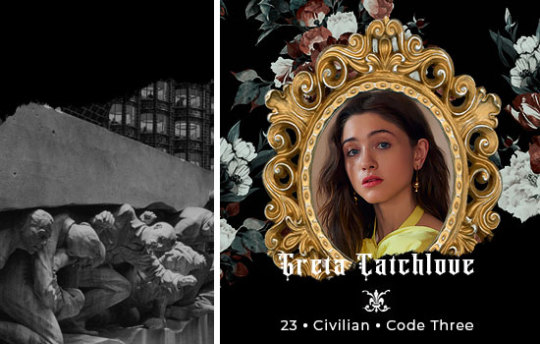
GRETA CATCHLOVE is a 23 year old HALFBLOOD, a former HUFFLEPUFF, and a BOOK SHOP-KEEP who is a CIVILIAN and uses SHE/HER pronouns. They are categorized as CODE THREE. They are currently CLOSED.
Daisies in a finished bottle of wine or soda | True strength lies in persisting in the darkness | Shy glances at your crush | The smell of freshly baked cinnamon rolls | Being underestimated for enjoying the simple things in life | Pressing flowers in notebooks | Muggle music playing from your records
HISTORY.
Greta Catchlove was welcomed into the world by two loving parents, who were beyond thrilled to have a beautiful baby girl. Her childhood was almost idyllic – she spent her time doing things that she loved with the people that she loved. Her parents fostered her creativity. Together, Greta and her parents would paint nonsense on blank canvases, read in the afternoon sun, hike, and spend their summers swimming and kayaking at nearby lakes. She was always fascinated by the beauty of the world around her, spending hours sitting in the back garden, just taking all of the beauty in. Watching the ladybugs, caterpillars and ants go about their days, marveling at mushrooms and ferns and oak trees. Greta quickly became the kind of person to give bees water or to save a worm from the pavement. The Catchlove’s never had an excess of money, but they were happy.
Her fascination with the world prompted Greta to start writing at a young age, at first making detailed notes about her observations, but then starting to run away with her imagination. She dreamt up tales of Princesses and Knights, life-sized ladybugs who could sing, tap dancing dragons, and much more, letting her vivid imagination run wild. When she was 11 and she received her Hogwarts letter, she was both excited and terrified. She’d never known anything other than life with her parents, but she was excited to embark on a new adventure, just like the ones that she made up in her imagination.
Tall and gangly, even for an 11-year-old, Greta made her way to Hogwarts, and was immediately sorted into Hufflepuff house. It wasn’t until she got to school that she realized the simple fact that not everyone was nice. She also had no idea how important blood status was becoming in the Wizarding world. Both of her parents were magical, but her Grandma was a Muggle, and Greta didn’t know how anyone could look down on someone as lovely as her Grandma. She never really excelled at her studies, but she never did poorly, either, enjoying subjects like Care of Magical Creatures and History of Magic more than Transfiguration or Charms. Greta enjoyed learning new things, but was never able to stop her imagination from running wild in the middle of her classes. She was friendly and warm, making a few friends, but was always a bit too introverted and sensitive to form any real bonds, worried about rejection from her more outgoing peers.
When the war started to rage, Greta knew that, while she absolutely held sympathies for those who were standing up to He Who Must Not Be Named and his band of bullies, she had nothing to offer the Order. She stayed neutral in the war, not because she didn’t support the cause, or think that everyone deserved to be treated equally, but because she was terrified for herself and her family. Greta was a writer, not a fighter, and didn’t feel strong or brave enough to make a difference. Her neutrality landed her the code three status, and even after the war ended, she has continued to try to keep her head down so as to not draw any attention. She may have been introverted before, but by the time the war ended, she had pretty much cut herself off from everyone, even her parents. They had both gone into hiding with Greta’s Grandma for her safety, and Greta is terrified for them all. She’s afraid that if she steps out of line, that something bad will happen to her family. There have been few who have been reaching out to her, and Greta appreciates it, trying to push herself to really form some deep connections.
After the war ended, Greta started to be plagued by guilt about her inaction, but she is very careful with who she lets her sympathies be known to. It is these sympathies that Sirius Black seems to be very aware of, and though her interactions with him have been pretty few and far between thus far, she’s incredibly worried of the dangers that come with being associated with Order members. It’s flattering that Sirius seems to think she’s capable of more than neutrality, but a small voice in the back of her head can’t help but think that he’s just grasping at straws for an ally. As usual, there’s an internal war raging inside her head - she’s still absolutely terrified of stepping a toe out of line in the new world order, but she’s starting to think that she needs to do more than just sit idly by while injustices happen. Greta is, of course, completely unaware that she’s being closely watched by the new regime, which is probably for the best, as knowing would completely ramp up her anxiety.
If there was one quality that her parents instilled into her, it was kindness. People tend to underestimate Greta because she’s soft spoken, gentle, and kind, but she thinks that there’s a great strength and courage in being kind in a cruel world. She is incredibly observant, noticing things about the world around her that others might miss. Though Greta is very sweet and kind, she tends to be quite sensitive, overly anxious, and overthinks things a lot. She’s more of a dreamer than a doer, letting herself get more lost in her imagination than she is grounded in reality. She has a good sense of humour when you get to know her, tries her best to be hopeful, is very down to earth, and cares incredibly deeply about others. Greta tends to be a bit gullible and naïve, is easily flustered and embarrassed, and certainly isn’t the most skilled witch of the bunch. She is, however, a very talented writer, and hopes that one day, by some miracle, the reign of terror will be over, and she’ll be able to publish one of the many books she’s started writing.
CONNECTIONS.
SIRIUS BLACK: Recruiter. Greta has caught him several times since he went into hiding along with the other newly minted fugitives of the law. She would never turn him in, since she doesn’t agree with the new Ministry or the treatment of muggleborns. However, she does wish he would stop coming to her and looking for her to join their cause. She can’t say how she truly feels about him seeing some strength in her that not many others have, but she doesn’t want to get involved in the dangers of the defeated Order of the Phoenix. She offers him all the help she can each time without accepting his offer to join.
ASLAN SHAFIQ: New Friend. They met at Flourish and Blotts when both were looking over books on herbology and charms. Truthfully, they both reached for the same book at the same time and their hands hit. Greta started talking to Aslan then and discovered that they had a lot in common in their interests and their views. She’s been keeping in touch with him since then and a new friendship is budding between them. It’s such a relief to her in these new days for her to find a new friend to fend off the darkness of the world with.
MOLLY WEASLEY: Companion. Greta started interviewing Molly for a book she was considering writing before the Death Eaters took over. She’d been playing with the idea of a book on charms one uses in the kitchen or one on herbology for your home. Over the afternoons with tea and little babbling babies on Molly’s knee, Great came to really appreciate the kindness, warmth and knowledge of the older witch. However, all hopes of her ever publishing a book like that, or about any topic, came to an end when the Ministry declared that only code ones could be published. She still enjoys talking to Molly when she can, even if it is no longer in pursuit of her book.
LUCINDA TALKALOT: Classmate. Though Lucinda was in a different house, Greta always admired her from afar when they were at Hogwarts. The two knew of each other, of course, being in the same year, and Greta always wanted to befriend Lucinda, but wasn’t entirely outgoing enough to know how. Greta always admired Lucinda’s take no prisoners attitude, respecting that she was a fighter who always stood up for herself. Lucinda always had qualities that Greta wished she could have more of – she would have loved to be able to stand up for herself more, but confrontation terrifies her. Since graduating, she’s seen Lucinda around, and always thinks about reaching out. She has nothing to lose, and isn’t quite sure what’s stopping her.
Currently portrayed by NATALIA DYER
#Greta Catchlove#Natalia Dyer fc#skeleton rp#hp rp#new rp#Natalia Dyer#female#halfblood#hufflepuff#civilian#code three#closed
5 notes
·
View notes
Note
a pro-shipper is someone who believes that any ship is okay because “fiction doesn’t affect reality” (including sensitive topics) and that there should be no “fandom police” telling them that it’s wrong. idk your last reblog had me a bit confused
I’ve never heard that phrase used before. No, I wouldn’t sort myself into that particular camp. However, I think the internet gets WAY too polarized about these things. Should people be romanticizing abuse or abusive relationships of any type? No, absolutely not. Ive always believed that fiction has a huge impact on reality (I’ve made posts about it before, but I’m on mobile rn so I’m too lazy to go find and link them), and the more people romanticize abuse in fiction, the more socially accepted it’s gonna become in real life. (See: all the studies about some of the the horrific effects of violent porn.)
However, I think the internet has somewhat lost its ability to differentiate between portraying something in order to explore or reflect upon a dark topic, and romanticizing or condoning that thing. Note how I said up there that people absolutely should not romanticize abuse. But if nobody ever made any kind of art or fiction that portrayed abuse, or any other kind of evil, how would we as individuals and as a society ever process, understand, or make progress? If we Disney-fy and bowdlerize every single thing, we will be an emotionally, morally, and philosophically stunted people.
I was actually just talking about this with a friend, perhaps I put it better there:
“Plus, people have this really weird assumption that portraying something in art in the same thing as.... doing it in actual real life? Which is absolutely ridiculous, not to mention damaging, because art and fiction have always been so much about exploring themes and thoughts and whatnot, and if you say "you must ONLY EVER explore MORALLY PURE things in fiction and never stray into dark or immoral subject matter!!!" ... that limits human thought and philosophy and morality SO MUCH.”
So, to address your ask:
“any ship is okay” nah, not exactly. I don’t support condoning, encouraging, or romanticizing abuse. (And to reference the post that started this, which I might link later when I’m not on mobile, “abuse” here of COURSE includes child abuse.) However, the internet really has to learn that portraying something is not tantamount to supporting or condoning it. If we were only ever allowed to make art about the things we supported or actually partook in, Agatha Christie would be the most accomplished serial killer of all time.
“There should be no fandom police” Actually yeah, I agree. Discussion board moderators and the like, for self contained fandom communities where there are built in guidelines? Yeah, sure. But fandom is a Wild West of art, fiction, and self expression. It’s a sandbox, as people have often described it. I’ll reference that earlier post again and say that if a fan feels that they need their hand held online, and they can’t blacklist tags, block content they don’t want to see, and manage their own fandom experience, then they’re probably too young to be unsupervised online. Again: this is not saying that “oh nazis are allowed to exist, just block them! :)” no. Obviously that’s different. But I think “fandom police” are entirely unnecessary. In my experience, such “police” operate very much like police in the real world: they don’t really make anything safer, they just harass people who are minding their own business.
Also, I don’t think people need “fandom police” to tell them what’s right or wrong. That’s just... I don’t want to be mean here, but that’s ridiculous. For one thing, if a fan genuinely needs a random internet stranger to come in and tell them “that’s morally wrong” in order to navigate morality, that fan is WAY too young to be unsupervised on the internet. For another thing, the idea that somebody (or multiple somebodies) should be tasked with going around decreeing moral value on various fandom trends and topics is just plain impractical. Who’s to say that person or those people are pure bastions of morality? It just doesn’t work that way.
Now, should people have constructive conversations about morality and ethics and philosophy, in and out of a fandom setting? Yes. Duh. That’s the only way human beings made it past the Paleolithic era as a species. And (again, because I feel like people are going to willfully misinterpret this), I’m not saying “oh absolutely any kind of behavior and any message and anything is fine because we all have different opinions uwu.” See the first paragraph. Punch Nazis, eat the rich, and spit in the face of racists, homophobes, and misogynists.
I’ll quote my conversation with a friend again because I feel like it really wraps up my thoughts here:
“Yeah the internet has really ruined the term "problematic." Nazis are problematic. Writing about nazis to explore themes of morality isn't problematic, it's a reflection on and exploration of morality and history. And people don't seem to be able to see the difference between those two things”
And finally, I really don’t see how “it’s your own responsibility to curate your fandom experience and filter out the things that make you uncomfortable; it’s everyone’s responsibility to properly tag and label content so it can be filtered and curated. It is not everyone else’s responsibility to restrict their art to your personal tastes.” ... is somehow equal to “everything is allowed and there are no moral restrictions or ethical code on the internet.” That’s a bit of a leap there.
#asks#anon#fandom on fandom#essay warning#look#I didn’t mean to write this much#but for fuckssake people#the internet has GOT to learn the difference#between exploring something in fiction#and condoning it in real life#the two are not the same#that’s also not the same as saying Anything Goes#like if I write a story about a murderer#that doesn’t mean I’m saying murder is good or okay#FURTHERMORE#it’s also important to recognize that if media glorifies or romanticizes serial killers#that’s bad#these things all coexist#they’re not mutually exclusive#the internet has completely forgotten how NOT to be polarized about everything#rant
5 notes
·
View notes
Text
ok I haven’t been participating in that Autism Acceptance Month Challenge thing because... executive dysfunction lmao.
but yesterday’s theme was autistic representation, and I’ve seen a lot of people use this subject to say they wish there were more complex autistic characters, more autistic characters who get more to do than Being Autistic, more stories addressing ableism, more autistic adult characters, etc.
and it’s made me think about one of my favourite canon autistic characters ever, who is sadly underrated because no one outside of the UK has heard of the show he’s from, but whom I think a lot of people would appreciate.
So. LET ME TELL YOU ALL ABOUT DYLAN KEOGH.

He’s a character from the BBC show Casualty (a medical drama series about the staff of a hospital emergency department), and some of the best canon autistic representation I’ve ever seen.
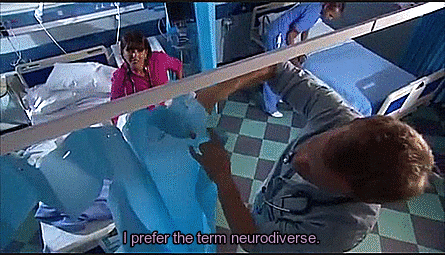
Dylan’s autism heavily impacts him as a character, but he isn’t just there to be The Autistic Member of the ED team. (In fact, there’s another autistic character on the show, a paramedic named Ruby Spark. No tokenism here, folks! Ruby is awesome too, but her autism is less directly focused on in the series - and confirmed by the actress rather than on-screen - so I’m mostly talking about Dylan in this post because his autism actually gets directly addressed in the series.) [ETA: As of May 2020, Ruby has left the show because the actress wanted to pursue other projects. She was a great character while she lasted though.]
He’s so much more than that. He gets to fall in love with people who aren’t good for him, to mentor younger staff members, to help refugee kids, etc. He gets to do everything the other characters do.
When his autism comes up, it’s handled fantastically. He’s no savant, the show makes that very clear - he’s very talented and intelligent, but he’s not a genius who can figure out what’s wrong with his patients right away or anything like that. Dylan wishes he could be a savant, sure, but he’s not.
Which is where one of my favourite aspects of Dylan’s character comes in. On the surface, he may look like an “asshole genius” stereotype. But! In reality, he’s quite the opposite. He can often be sarcastic and snippy and impatient with people, and very closed off, but this doesn’t come from his autism so much as it comes from rebelling against the way the world has treated him. It’s a “You think I’m weird and rude? Fine then, I’ll be weird and rude!” kind of thing more than anything, but he can still open up and be a lovely man when he wants to.
Part of Dylan’s backstory is that his father physically and emotionally abused him for being autistic, and the show makes NO ATTEMPT to justify this or go “but Brian [Dylan’s father] was under such stress raising an autistic kid!” or anything like that. It’s portrayed as what it is: repulsive, abusive, and just flat-out morally wrong behaviour.
Throughout the show, Dylan has often had to deal with ableism of all kinds. It’s ranged from the past abuse and recurrent ableist comments from his father, to an Autism Mum who assumes he’s ‘not like her child’, to little microaggressions even from well-intentioned people. (In one episode from 2015, Dylan’s best friend at the time, a nurse called Lofty, makes a comment about Dylan not really seeming human and probably being “an alien sent to study us”. It’s all in jest, but Dylan overhears and is hurt by it - and by the end of the episode, Lofty realises what he said was wrong.) They don’t make this into a Very Special Episode or a “zomg please don’t bully the poor autistic angels” kind of thing, either, it’s shown as a legitimate and unfair form of prejudice.
I want to expand on the part about the Autism Mum for a moment: this was Series 26 Episode 10, ‘Sanctuary’, and for the love of god, even if you never watch any other Casualty episodes, please just watch that one. In fact, it’s the one I took the gif earlier in this post from. It calls out ableism and allistic parents who paint themselves as martyrs, and features Dylan (the sort of character they easily could’ve made into a ‘shiny Aspie’) bonding with an autistic woman who has higher support needs and treating her as an equal. The episode shows that even though many would class Dylan as “high-functioning” and the autistic woman, Angela, as “low-functioning”, they have more in common than what divides them. It’s fantastic and incredibly ahead of its time.
There are so many more reasons I love Dylan, but this post is long enough already, so I’ll just stop here and hope I’ve already inspired some interest in his character. Dylan may not be perfect representation (he is, admittedly, another white straight man, and the show plays his touch sensitivity for laughs a little too often for my liking), but IMHO, he’s pretty damn close. And I think he deserves much more recognition and appreciation as autistic rep than he gets.
#actuallyautistic#actually autistic#autism#BBC Casualty#Dylan Keogh#hopefully this version will actually show up in the tags lmao
46 notes
·
View notes
Text
Cross-Cultural Design
When I first traveled to Japan as an exchange student in 2001, I lived in northern Kyoto, a block from the Kitayama subway station.
My first time using the train to get to my university was almost a disaster, even though it was only two subway stops away. I thought I had everything I needed to successfully make the trip. I double- and triple-checked that I had the correct change in one pocket and a computer printout of where I was supposed to go in the other. I was able to make it down into the station, but then I just stood at a ticket machine, dumbfounded, looking at all the flashing lights, buttons, and maps above my head (Fig 5.1). Everything was so impenetrable. I was overwhelmed by the architecture, the sounds, the signs, and the language.

Fig 5.1: Kyoto subway ticket machines—with many line maps and bilingual station names—can seem complicated, especially to newcomers.
My eyes craved something familiar—and there it was. The ticket machine had a small button that said English! I pushed it but became even more lost: the instructions were poorly translated, and anyway, they explained a system that I couldn’t use in the first place.
Guess what saved me? Two little old Japanese ladies. As they bought tickets, I casually looked over their shoulders to see how they were using the machines. First, they looked up at the map to find their desired destination. Then, they noted the fare written next to the station. Finally, they put some money into the machine, pushed the button that lit up with their correct fare, and out popped the tickets! Wow! I tried it myself after they left. And after a few tense moments, I got my ticket and headed through the gates to the train platform.
I pride myself on being a third-culture kid, meaning I was raised in a culture other than the country named on my passport. But even with a cultural upbringing in both Nigeria and the US, it was one of the first times I ever had to guess my way through a task with no previous reference points. And I did it!
Unfortunately, the same guesswork happens online a million times a day. People visit sites that offer them no cultural mental models or visual framework to fall back on, and they end up stumbling through links and pages. Effective visual systems can help eliminate that guesswork and uncertainty by creating layered sets of cues in the design and interface. Let’s look at a few core parts of these design systems and tease out how we can make them more culturally responsive and multifaceted.
Typography
If you work on the web, you deal with typography all the time. This isn’t a book about typography—others have written far more eloquently and technically on the subject. What I would like to do, however, is examine some of the ways culture and identity influence our perception of type and what typographic choices designers can make to help create rich cross-cultural experiences.
Stereotypography
I came across the word stereotypography a few years ago. Being African, I’m well aware of the way my continent is portrayed in Western media—a dirt-poor, rural monoculture with little in the way of technology, education, or urbanization. In the West, one of the most recognizable graphic markers for things African, tribal, or uncivilized (and no, they are not the same thing) is the typeface Neuland. Rob Giampietro calls it “the New Black Face,” a clever play on words. In an essay, he asks an important question:
How did [Neuland and Lithos] come to signify Africans and African-Americans, regardless of how a designer uses them, and regardless of the purpose for which their creators originally intended them? (http://bkaprt.com/ccd/05-01/)
From its release in 1923 and continued use through the 1940s in African-American-focused advertising, Neuland has carried heavy connotations and stereotypes of cheapness, ugliness, tribalism, and roughness. You see this even today. Neuland is used in posters for movies like Tarzan, Jurassic Park, and Jumanji—movies that are about jungles, wildness, and scary beasts lurking in the bush, all Western symbolism for the continent of Africa. Even MyFonts’ download page for Neuland (Fig 5.2) includes tags for “Africa,” “jungle fever,” and “primitive”—tags unconnected to anything else in the product besides that racist history.
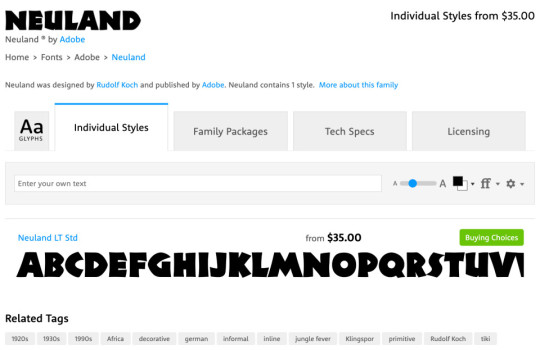
Fig 5.2: On MyFonts, the Neuland typeface is tagged with “Africa”, “jungle fever”, and “primitive”, perpetuating an old and irrelevant typographic stereotype (http://bkaprt.com/ccd/05-02/).
Don’t make, use, or sell fonts this way. Here are some tips on how to avoid stereotypography when defining your digital experiences:
Be immediately suspicious of any typeface that “looks like” a culture or country. For example, so-called “wonton” or “chop-suey” fonts, whose visual style is thought to express “Asianness” or to suggest Chinese calligraphy, have long appeared on food cartons, signs, campaign websites, and even Abercrombie & Fitch T-shirts with racist caricatures of Asians (http://bkaprt.com/ccd/05-03/). Monotype’s website, where you can buy a version called Mandarin Regular (US$35), cringingly describes the typeface’s story as “an interpretation of artistically drawn Asian brush calligraphy” (Fig 5.3). Whether or not you immediately know its history, run away from any typeface that purports to represent an entire culture.
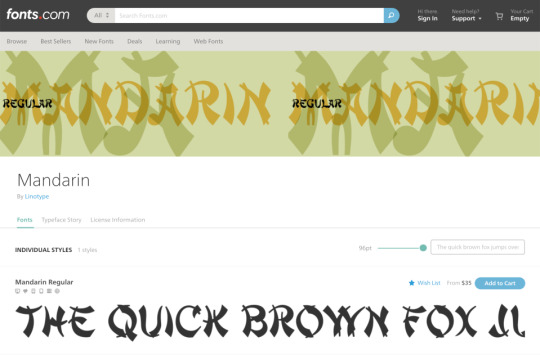
Fig 5.3: Fonts.com sells a typeface called Mandarin Regular with the following description: “The stylized Asian atmosphere is not created only by the forms of the figures but also by the very name of the typeface. A mandarin was a high official of the ancient Chinese empire” (https://ift.tt/2T4LppO).
Support type designers who are from the culture you are designing for. This might seem like it’s a difficult task, but the internet is a big place. I have found that, for clients who are sensitive to cultural issues, the inclusion of type designers’ names and backgrounds can be a powerful differentiator, even making its way into their branding packages as a point of pride.
The world wide webfont
Another common design tool you should consider is webfonts—fonts specifically designed for use on websites and apps. One of the main selling points of webfonts is that instead of putting text in images, clients can use live text on their sites, which is better for SEO and accessibility. They are simple to implement these days, a matter of adding a line of code or checking a box on a templating engine. The easiest way to get them on your site is by using a service like Google Fonts, Fontstand, or Adobe Fonts.
Or is it? That assumes those services are actually available to your users.
Google Fonts (and every other service using Google’s Developer API) is blocked in mainland China, which means that any of those nice free fonts you chose would simply not load (http://bkaprt.com/ccd/05-05/). You can work around this, but it also helps to have a fallback font—that’s what they’re for.
When you’re building your design system, why not take a few extra steps to define some webfonts that are visible in places with content blocks? Justfont is one of the first services focused on offering a wide range of Chinese webfonts (http://bkaprt.com/ccd/05-06/). They have both free and paid tiers of service, similar to Western font services. After setting up an account, you can grab whatever CSS and font-family information you need.
Multiple script systems
When your design work requires more than one script—for instance, a Korean typeface and a Latin typeface—your choices get much more difficult. Designs that incorporate more than one are called multiple script systems (multiscript systems for short). Combining them is an interesting design challenge, one that requires extra typographic sensitivity. Luckily, your multiscript choices will rarely appear on the same page together; you will usually be choosing fonts that work across the brand, not that work well next to one another visually.
Let’s take a look at an example of effective multiscript use. SurveyMonkey, an online survey and questionnaire tool, has their site localized into a variety of different languages (Fig 5.4). Take note of the headers, the structure of the text in the menu and buttons, and how both fonts feel like part of the same brand.


Fig 5.4: Compare the typographic choices in the Korean (http://bkaprt.com/ccd/05-07/) and US English (http://bkaprt.com/ccd/05-08/) versions of SurveyMonkey’s Take a Tour page. Do the header type and spacing retain the spirit of the brand while still accounting for typographic needs?
Some tips as you attempt to choose multiscript fonts for your project:
Inspect the overall weight and contrast level of the scripts. Take the time to examine how weight and contrast are used in the scripts you’re using. Find weights and sizes that give you a similar feel and give the page the right balance, regardless of the script.
Keep an eye on awkward script features. Character x-heights, descenders, ascenders, and spacing can throw off the overall brand effect. For instance, Japanese characters are always positioned within a grid with all characters designed to fit in squares of equal height and width. Standard Japanese typefaces also contain Latin characters, called romaji. Those Latin characters will, by default, be kerned according to that same grid pattern, often leaving their spacing awkward and ill-formed. Take the extra time to find a typeface that doesn’t have features that are awkward to work with.
Don’t automatically choose scripts based on superficial similarity. Initial impressions don’t always mean a typeface is the right one for your project. In an interview in the book Bi-Scriptual, Jeongmin Kwon, a typeface designer based in France, offers an example (http://bkaprt.com/ccd/05-09/). Nanum Myeongjo, a contemporary Hangul typeface, might at first glance look really similar to a seventeenth-century Latin old-style typeface—for instance, they both have angled serifs. However, Nanum Myeongjo was designed in 2008 with refined, modern strokes, whereas old-style typefaces were originally created centuries ago and echo handwritten letterforms (http://bkaprt.com/ccd/05-10/). Looking at the Google Fonts page for Nanum Myeongjo, though, none of that is clear (Fig 5.5). The page automatically generates a Latin Nn glyph in the top left of the page, instead of a more representative Hangul character sample. If I based my multiscript font choices on my initial reactions to that page, my pairings wouldn’t accurately capture the history and design of each typeface.
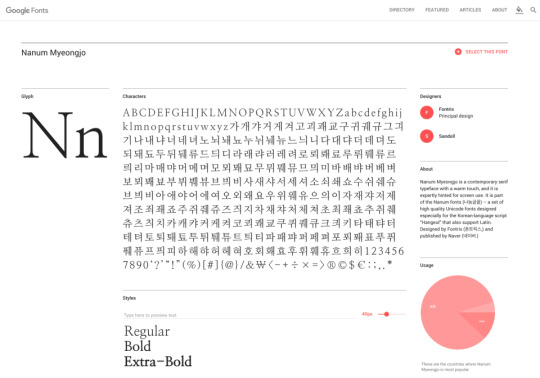
Fig 5.5: The Google Fonts page for Nanum Myeongjo shows a Latin character sample in the top left, rather than a more representative character sample.
Visual density
CSS can help you control visual density—how much text, image, and other content there is relative to the negative space on your page. As you read on, keep cultural variables in mind: different cultures value different levels of visual density.
Let’s compare what are commonly called CJK (Chinese, Japanese, Korean) alphabets and Latin (English, French, Italian, etc.) alphabets. CJK alphabets have more complex characters, with shapes that are generally squarer than Latin letterforms. The glyphs also tend to be more detailed than Latin ones, resulting in a higher visual density.
Your instinct might be to create custom type sizes and line heights for each of your localized pages. That is a perfectly acceptable option, and if you are a typophile, it may drive you crazy not to do it. But I’m here to tell you that when adding CJK languages to a design system, you can update it to account for their visual density without ripping out a lot of your original CSS:
Choose a font size that is slightly larger for CJK characters, because of their density.
Choose a line height that gives you ample vertical space between each line of text (referred to as line-height in CSS).
Look at your Latin text in the same sizes and see if it still works.
Tweak them together to find a size that works well with both scripts.
The 2017 site for Typojanchi, the Korean Typography Biennale, follows this methodology (Fig 5.6). Both the English and Korean texts have a font-size of 1.25em, and a line-height of 1.5. The result? The English text takes up more space vertically, and the block of Korean text is visually denser, but both are readable and sit comfortably within the overall page design. It is useful to compare translated websites like this to see how CSS styling can be standardized across Latin and CJK pages.

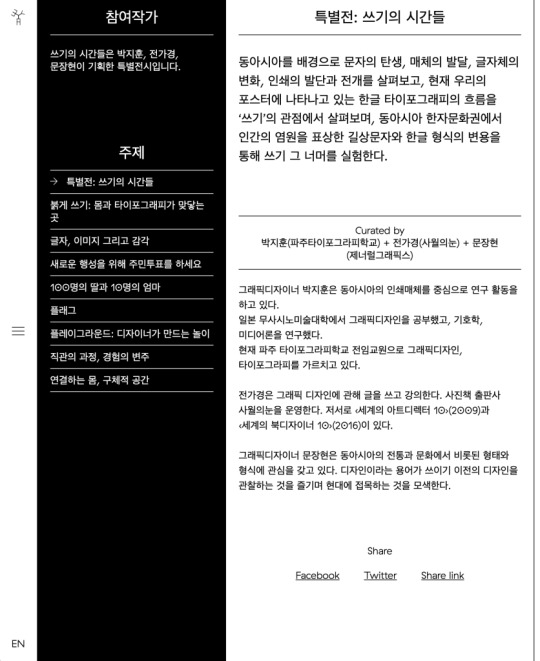
Fig 5.6: The 2017 site for Typojanchi, the Korean Typography Biennale, shows differing visual density in action. It is useful to compare translated websites like this to see how CSS styling can be standardized across Latin and CJK pages (https://ift.tt/2T2Emhi).
Text expansion factors
Expansion factors calculate how long strings of text will be in different languages. They use either a decimal (1.8) or a percentage (180%) to calculate the length of a text string in English versus a different language. Of course, letter-spacing depends on the actual word or phrase, but think of them as a very rough way to anticipate space for text when it gets translated.
Using expansion factors is best when planning for microcopy, calls to action, and menus, rather than long-form content like articles or blog posts that can freely expand down the page. The Salesforce Lightning Design System offers a detailed expansion-factor table to help designers roughly calculate space requirements for other languages in a UI (Fig 5.7).
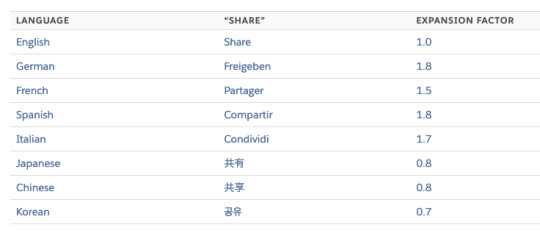
Fig 5.7: This expansion-factor table from Salesforce lets designers and developers estimate the amount of text that will exist in different languages. Though dependent on the actual words, such calculations can give you a benchmark to design with content in mind (http://bkaprt.com/ccd/05-12/).
But wait! Like everything in cross-cultural design, nothing is ever that simple. Japanese, for example, has three scripts: Kanji, for characters of Chinese origin, hiragana, for words and sounds that are not represented in kanji, and katakana, for words borrowed from other languages.
The follow button is a core part of the Twitter experience. It has six characters in English (“Follow”) and four in Japanese (フォロー), but the Japanese version is twenty percent longer because it is in katakana, and those characters take up more space than kanji (Fig 5.8). Expansion tables can struggle to accommodate the complex diversity of human scripts and languages, so don’t look to them as a one-stop or infallible solution.


Fig 5.8: On Twitter, expansion is clearly visible: the English “Follow” button text comes in at about 47 pixels wide, while the Japanese text comes in at 60 pixels wide.
Here are a few things you can do keep expansion factors in mind as you design:
Generate dummy text in different languages for your design comps. Of course, you should make sure your text doesn’t contain any unintentional swearwords or improper language, but tools like Foreign Ipsum are a good place to start getting your head around expansion factors (http://bkaprt.com/ccd/05-13/).
Leave extra space around buttons, menu items, and other microcopy. As well as being general good practice in responsive design, this allows you to account for how text in your target languages expands.
Make sure your components are expandable. Stay away from assigning a fixed width to your UI elements unless it’s unavoidable.
Let longer text strings wrap to a second line. Just ensure that text is aligned correctly and is easy to scan.
Cross-Cultural Design published first on https://deskbysnafu.tumblr.com/
0 notes
Text
Emotional abuse: The warning signs
By Lauren Williams.
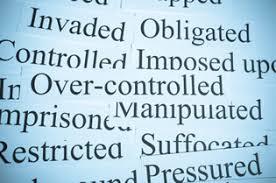
In my experience, nothing can be more damaging to a person’s self-esteem and wellbeing than being trapped in an emotionally abusive relationship of any kind. Generally, people have no trouble identifying physical abuse as it’s pretty black and white; it tends to kick off in dramatic outbursts and they physically hurt you. Most people would take it very seriously if somebody disclosed that they were experiencing physical violence, however this is not always the case for emotional abuse. This is because it’s not black and white at all. It’s subtle, difficult to spot and often overlooked because people simply are not aware of what emotional abuse is, even though it is equally as unacceptable and often more damaging.
How can it possibly be more damaging? Because it creeps up on you. Often, the victim doesn’t realise it is happening until things escalate and it is extremely difficult to find a way out. Victims may be led to believe that abusive behaviours are ‘normal’ or even ‘loving.’ It slowly disintegrates the victim's sense of self value, self-esteem, trust in themselves and in others. It can undermine the way we think about ourselves and can make us question our own sanity. It leaves psychological scars and emotional pain that can take a long time to heal and the victim is left to deal with this pain even after they have left the relationship. It’s painfully isolating and no-one deserves to experience this, but the reality is it’s extremely common.
You may be reading and thinking ‘this would never apply to me or anyone I know’ but in fact, domestic abuse affects 1 in 3 women and 1 in 4 men in the UK which is a lot of people. Abusers do not discriminate and it is possible for anybody, regardless of gender, age, background to find themselves caught up in this, and for that reason it is an issue we all need to be aware of. Abuse doesn’t just occur in romantic relationships, but it can also be present in relationships with friends, family, colleagues and bosses. I genuinely believe that one of the first steps towards creating safer and healthier relationships is awareness and education around this issue, hence I am writing this in order to highlight the classic warning signs of an abusive relationship, as these behaviours should not be tolerated. I’m not an expert by any means but I know enough from personal and professional experience working as an Independent Domestic Abuse Advisor (IDVA) for my placement year, which was very fulfilling and from which I learned a lot. It is a subject I feel very strongly about which is why I have joined Cardiff University’s Domestic Violence Awareness Society and why I am writing this, to start a conversation about this very serious issue. Reading this will take just 10 minutes of your time, and you might learn something useful.
So, first of all what is emotional abuse? Emotional abuse is characterised by a person subjecting another person to behaviour that may result in psychological trauma, including anxiety, chronic depression, or post-traumatic stress disorder. This can include verbal abuse, threatening, bullying, shaming, manipulating and controlling your partner. Not sure what constitutes this exactly? Here are some examples:
1. They put you down and belittle you – Abusive people will constantly put you down with hurtful comments because the more insecure you are, the easier you are to manipulate and control. These comments could be about anything; your appearance, intelligence, career, values but they’ll always find something to belittle. They will brush off your achievements and may even make you feel guilty about them. Got a promotion at work? They won’t celebrate with you but they may say ‘Well I guess you’ll be too busy with work to have time for me then’ or ‘Oh is that it?’ because they don’t want to see you succeed. If you ask them to stop saying those things because it hurts your feelings, they will claim that you’re being ‘too sensitive’ or it was ‘just a joke’.
2. Arguments are about inflicting pain and winning, not solving problems – Everyone has arguments right, but how you handle yourself in an argument speaks volumes about you as a person. Instead of sitting down calmly and hashing it out like adults, abusive people will be focussed on hurting you and winning the fight. Even if you go to them in a completely civil and rational way, like ‘Hey can I talk to you about something that’s upsetting me?’ they will still perceive it as an attack and will always meet you with aggression. They will try to ‘one up’ you and say things that are below the belt for maximum impact to make you as jealous or as angry as they currently feel, because that is the only way they know how to deal with the situation. They will viciously tear you down because once you’re feeling hurt and insecure yourself, you are less of a threat to them.
3. You are always the problem – They will never, ever admit when they are wrong therefore everything must be your fault. Any relationship issues you may be having are down to you and what you’re doing wrong, because they are the perfect partner. Their behaviour is not abusive at all, it’s just ‘protective’ or an expression of their ‘love’ which you are clearly not grateful for. They will tell you they are the ‘best thing that has ever happened to you’ and that you’re ‘so lucky to have them because no one else would ever want you’. This is a hallmark of an abusive person, as most people are happy to admit and apologise for their mistakes but abusers have such fragile self-esteem they try to portray themselves as a superior, perfect people. Instead of acknowledging that they actually did something wrong, they will convince you that everything is your fault and when someone close to you tells you this constantly, then you will likely start to believe them and feel terrible about yourself, even though it’s not true. Remember these people are master manipulators and can get in your head.
4. They try to control you and do not allow you to have privacy – They want to know where you are at all times, who you’re with and whether there is anyone there who could be deemed threatening. They will tell you what to wear, what to eat and drink, what you can post on social media and who you are allowed to talk to. They may tell you to delete people they don’t like off social media and if you refuse to do so, they will do it without your permission anyway. If they cannot physically stop you doing something, then they will make it as psychologically unpleasant as possible for you if you ‘disobey’ them and eventually you will start to comply for the sake of an easy life. They know your social media and phone passwords but you’re not allowed theirs, which is fine because secure people should not need to go through their partner’s phone when they are not aware. If you say you don’t want them to do this because it’s an invasion of privacy, they say ‘What are you hiding from me then?’ You are 100% entitled to your privacy and a healthy partner would respect that, but abusive people will not.
5. They try to isolate you – An abuser doesn’t want you to have a social support network because then you’re more likely to leave them. The more alone you are, the more stuck you are. For example, if you want to go out with your friends they will make you feel so guilty or upset beforehand, that you will end up not wanting to go, or constantly bombard you with messages when you are out of the house to ruin your night. Eventually you may stop socialising altogether to avoid the consequences.
6. They convince you that you’re insane- This is called ‘gas lighting’ which is a subtle form of manipulation that aims to make you question your own memory, perception, and sanity just enough to sow the seeds of doubt. They deny things you know definitely happened but will go to ridiculous lengths to try and convince you they didn’t happen, making you question yourself. For example, perhaps you suspect infidelity but when you ask them about it and they completely deny knowing the person in question, even if you can recall several times they have met. Another example could be deleting texts or pictures from your phone but denying they touched it, but you know something is missing but you just can’t prove it.
7. They make wild accusations – Guilty people accuse. Many abusers constantly accuse their partner of cheating when there is no evidence of any infidelity. Often, victims have very little contact with anybody without their partner being present anyway so despite not having the opportunity to be unfaithful, they will still be accused. Something as normal as wanting to exercise can be turned into ‘Who are you seeing at the gym?’ It’s relentless and if they are behaving this way then they are more likely to be cheating on you.
8. They threaten you in subtle ways- One touch or one particular look in public to make you know that you have done something very ‘wrong’ and that you will receive the consequences later.
9. You feel like you’re stepping on eggshells - You feel a constant sense of anxiety and discomfort when around them because you are aware of how volatile they are. You may feel like you are constantly stepping on egg shells, waiting for them to snap so you can never truly relax.
10. They blame you for things out of your control – You are terrified that anyone may look at you or even attempt to talk to you because they will blame you. Even if you politely decline their advances, you obviously ‘asked’ for it from your body language and with the ‘provocative’ clothes you were wearing. If they have a bad day, they will use you as their emotional punching bag. Healthy couples should not take their bad mood out on their partner or blame them for things that they had no control over.
11. They cannot stand being laughed at or laugh at themselves – They can make fun of you, humiliate and criticise you to their hearts desire, but if you were to make a joke about them, laugh at their expense or even try to give them constructive criticism, they will lose their temper and you will be sorry you did.
12. Whirlwind romance – As a general rule, emotional abuse and moving fast in a relationship tend to go hand in hand. They may want to take your relationship to the next stage such as moving in together which can be great for healthy couples, but for abusers this will just be another way to control and isolate you. If you say you’re not ready, they question your commitment and loyalties to them because ‘who are you planning on leaving them for anyway’? The more commitments you have with somebody abusive e.g. a house, a child and marriage the more stuck you are which is exactly their motive. People reveal their true selves after a while, which is why it is good to take things slow and get to know somebody before deciding whether you want to be with them.
13. They will guilt trip you - They love playing the victim and they will make any excuse under the sun for their controlling behaviour. ‘My ex cheated on me which is why I don’t trust you’ or ‘I’m doing this because I love you’. ‘Do you not love me anymore, is that why you don’t want sex? Or are you getting it from somewhere else?’
14. Erratic ups and downs – Your relationship is like a roller-coaster, one minute everything is fine, they are telling you that you are the love of their life and the next they are screaming at you for attracting another person’s attention. Their anger can go from 0 to 100 in two seconds flat and it’s exhausting. Healthy relationships can still have ups and downs, but they are generally a lot less erratic and extreme than abusive relationships.
15. They won’t let you walk away– If you say you want to end the relationship, they will try everything they can think of to make you stay including emotional blackmail, apologising profusely, promising change that will never happen and perhaps threatening you. They may say things like ‘You will never find another person who will love you, this is the biggest mistake of your life’ or ‘If you leave me for another man, I’ll kill you both.’ They may shower you with gifts and flowers to say ‘sorry’ but this is generally just another manipulation strategy. They will not be able to respect your decision.
16. Once they can no longer control you, they will try to control the way people perceive you – When you leave an abusive person, a big backlash should be expected, because they will be absolutely furious that you have regained control. They will speak about you in a derogatory way to others, tell lies or exaggerations about you to anyone who will listen, perhaps try to interfere with any future relationships or job prospects because they will likely want revenge. This can be very scary and unpleasant, but this says more about them than you and the people who truly know you will know it’s all just rooted in resentment rather than truth. If you are truly concerned for your safety in this event, then reporting incidents to the police or a domestic abuse agency would be the best course of action.
Moving forward:
People who have suffered abuse tend to ask ‘How did I let this happen? How did I not see it before? Was this my fault? The answer to that is no, it is never the victims fault. Abusive people are master manipulators, compulsive liars and they are extremely good at convincing you that they are somebody they are not, so it’s natural that people tend to take them and what they say at face value at first. Unless you are educated on the warning signs of abuse, there was no way you could have known what this person was going to turn out to be like, so don’t put any of the blame on yourself. Sometimes you can’t help getting caught up in someone else’s issues and they are their issues, not yours.
Many people ask ‘Will they change?’ and the short answer is no, it is extremely unlikely that they will ever change. This is who they are, as abusive traits are usually deeply engrained learned behaviours that are very difficult to un-learn. The only way a person would change is if they actually wanted to and many abusers do not even recognise they are doing anything wrong, let alone are motivated to change, besides what’s in it for them? It would take professional help and deep self-insight (which most do not have) for an abusive person to change. I understand having emotional ties with a person makes it difficult to just walk away and you may be scared of the repercussions of doing so, but there are agencies you can contact for advice and support around this matter. They are educated about abuse and will want to help.
This was not written from some sort of moral high ground but it was written to raise awareness and to reduce stigma around emotional abuse. The fact is we are all humans who make mistakes, have imperfections and we all come with past wounds and baggage from previous experiences. However, the whole point of a healthy, nurturing relationship is to find someone who accepts you for who you are. Someone with whom you can mutually support and heal each other, not someone you are constantly battling with. It is every person’s right to have healthy and loving relationships with others around them and experiencing abuse does not have to tarnish the way you view relationships. If you have experienced abuse, there is help available out there for you if you should want it and you can use this experience to learn, grow and make more informed choices next time. Such an experience does not have to define you or your future relationships. Good relationships should not make you feel constantly anxious, depressed, belittled, disrespected, or scared. It doesn’t matter how much they tell you they do it because they ‘love’ you, it’s not acceptable. Someone who loves you will respect you, listen to you, compromise for you, go out of their way to make you happy, respect your boundaries and privacy, accept your shortcomings and make you feel like you are a part of a team, not in a constant power struggle and toxic cycle.
If anybody is affected or knows somebody who may be affected by these issues, then there is support available through the links below and I would encourage you to talk to someone, because you should not have to deal with this alone.
Thank you for listening :)
Useful links:
https://www.womensaid.org.uk/
http://www.mensadviceline.org.uk/
http://www.counselling-directory.org.uk/emotional-abuse.html
https://www.nhs.uk/livewell/abuse/pages/domestic-violence-help.aspx
0 notes
Text
Reading #3 : Allergy to Originality by Drew Christie
Portrait of Drew Christie (below):

CRITIQUE
FEEL:
This was a very interesting reading in that the author, Drew Christie, used two mediums –
a traditional short text Op-Ed piece, and,
a simply executed, but sophisticated – also short – animation.
I felt that Christie was striving to achieve an ironic, but intellectual approach.
He is dramatizing a creative world that is seemingly short on unique output.
All in, I felt entertained, impressed, and informed -
Christie communicated a serious quantity of ideas with deft strokes, literally and figuratively.
ELEMENTS & PRINCIPLES: Christie’s main thrust is through the animation, but the text is equally effective at both generating interest and presenting his ideas in a concise fashion. The text nicely sets the stage for the viewer:
LINE: Because the animation consists entirely of contour drawings, LINE is the dominant element. The slight shaking of the hand drawn images in the animation holds the viewer attention. The images are simply and relatively realistically drawn, presenting a folksy, small-town honesty. This is amusing, given the overall level of conceptual sophistication.
SHAPE: There are easily recognizable SHAPES utilized throughout the animation. Christie uses basic shapes and figures to give the viewer the impression that this could be any small movie theater in Smalltown, USA.
COLOR: Christie leverages a small number of COLORS to attract the viewer’s attention. There are essentially only two muted colors, red and yellow. The background is a very light tan, and gives the appearance of actual drawing paper. The overall use of color is restrained and judicious, but the effect is eye-catching and entertaining.
FORM: The setting is a movie patron talking to a ticket clerk. The FORMS are convincing to portray the physical aspects of the sidewalk, theater entrance, and two human figures. The contour drawings employ perspective throughout the animation, which adds to the credibility of the scene.
SPACE: The patron is shown walking and then engaging with the clerk in a specific setting. The use of SPACE gives a sense of an authentic street, movie theater, and ticket booth. There is a definite sense of depth, but in a basic way to keep the viewer amused with the scenario.
BALANCE: Christie has a small number of viewpoints, but they are essential for the viewer to stay engaged with the characters. We see the theater in the street with a pedestrian, but we also get face-to-face with the two characters. Christie BALANCES the forms within the narrative to shift attention back and forth, from characters to setting to referenced images, such as a piece of art or Bob Dylan.
MOVEMENT: The clerk does not move, except via animation shakes. Also, his lips don’t move very much either even though he speaks a lot. This use of non-movement is very amusing – maybe he is an android. The patron walks and gestures in a convincingly human manner. The contrast in MOVEMENT is effective is supporting Christie’s ersatz Turing Test.
IDEA: Christie is leveraging a scenario where a movie patron is frustrated that Hollywood seems to only produce unoriginal fare. This is Christie’s overarching theme – not only movies, but every creative idea is not creative at all:
The banter between the characters, as well as the supporting text piece, is deceptively simple. Christie is raising, in my, opinion, many issues.
For instance, it is clear that all unoriginality is not all bad.
Or, plagiarism is bad but not so cleanly defined and adjudicated.
Or, we humans have been unoriginal for eons.
The items for debate are not limited to only these. We can delve – image by image – and discuss, for instance, the artistic merit of Duchamp’s Readymades (see below).
Although many questions remain, we have been entertained and informed in a creative way, and, we can debate from a more enlightened view.

HOW: This is a nicely executed animation of basic drawings:
As such, it appears a fair amount of actual paper and ink was utilized.
The dubbing of voices and music is entertaining. These details support the narrative.
I would guess that both a sound studio and an animation studio were used, given the high quality.
INTERESTING STUFF

One of the all-time most popular radio hosts was Paul Harvey (above). He had a distinctive voice with very idiosyncratic speaking mannerisms (cue SNL skits). Reading and seeing Christie’s piece – particularly the voice overs – made me think of Harvey, even though it is dissimilar in style and content. What I am getting at is The Rest of the Story, which was one of Harvey’s most popular segments. Christie’s piece is concise, even though chock full of ideas. I would like to bring up the following items as both filling out things I thought were interesting, and, providing impetus for discussion. So – homage to Harvey – here is the rest of the story:
HOMAGE: Now, there’s a fun word:
If you would like an air of intellectual affectation, you can pronounce it with a silent “h,” a long “o,” and extra long “azh” at the end (ō-ˈmäzh, vice hä-mij).
Interesting – maybe to only me – is that neither Christie nor Wikipedia make direct reference to homage as a source of unoriginality.
I think many artists are exercising the concept of homage when they apply concepts from their forebears. Moves Like Jagger, for example, is apropos.
NEWS THIS WEEK: Christie says in the text, “Unoriginality — or, maybe, excessive originality — being very much in the NEWS THIS WEEK, as students of the creative process and Bob Dylan buffs are well aware.” (my emphasis) I was curious, “What is Christie referencing?”
Well, at the time of Christie’s piece, a journalist was fired by the New Yorker magazine for fabricating quotes from Bob Dylan, of all people.
Additionally ironic, the journalist did this in a book titled, Imagine: How Creativity Works. Indeed.

ANDREI TARKOVSKY (above) and SERGEI EISENSTEIN (below): I thought it would be interesting to see photographic images of these gentlemen:
I can only speculate as to why Christie would use these two RUSSIAN film directors:
Maybe Christie has deep regard for these highly reputed and distinctive directors.
Maybe, because both are foreign and no longer with us, there would be little to no fallout.
There might be significant fallout from local, living (overly sensitive?) directors.
I thought Christie gave the characters distinctively American voices in very convincing and entertaining fashion. I would be shocked if either director ever spoke in that vernacular.
I thought it interesting and ironic that one of Tarkovsky’s works, SOLARIS, was the subject of an American version with George Clooney.
In any regard, the biographies of both Tarkovsky and Eisenstein are well worth reading.
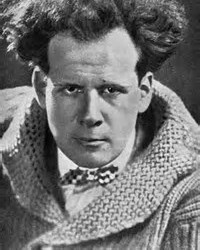
ROGETING: I read both of the Wikipedia entries – plagiarism and originality – mentioned in the animation -
I thought it interesting “the practice of plagiarizing by use of sufficient word substitutions to elude detention (sic) software, known as ROGETING, has rapidly evolved as students and unethical academics seek to stay ahead of detection software.”
I had a well-worn Roget’s Thesaurus (like below) at one time.
I would think even Rogeting will not be sufficient against the ever-enabled artificial intelligentsia.
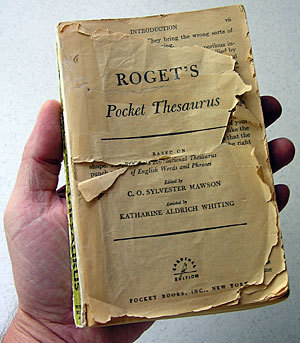
MARK TWAIN: The ticket clerk quotes Mark Twain to some length. I was curious to read and understand the context -
The quote is from a letter that Twain wrote to Helen Keller as he was ruminating the charges against Keller as a plagiarizer.
The letter contains classic Twain-ian verbal stylings and many pithy ideas.
I thought this quote worthy of further discussion: “These object lessons should teach us that ninety-nine parts of all things that proceed from the intellect are plagiarisms, pure and simple; and the lesson ought to make us modest. But nothing can do that.”
Twain is unquestionably distinctive. His surrender to reality is reassuring to us lesser able fabricators.
DALI: The author of the piece on Twain’s letter ends with a quote from a distinctively real – and unreal – artist, Salvador Dali: “Those who do not want to imitate anything, produce nothing.”
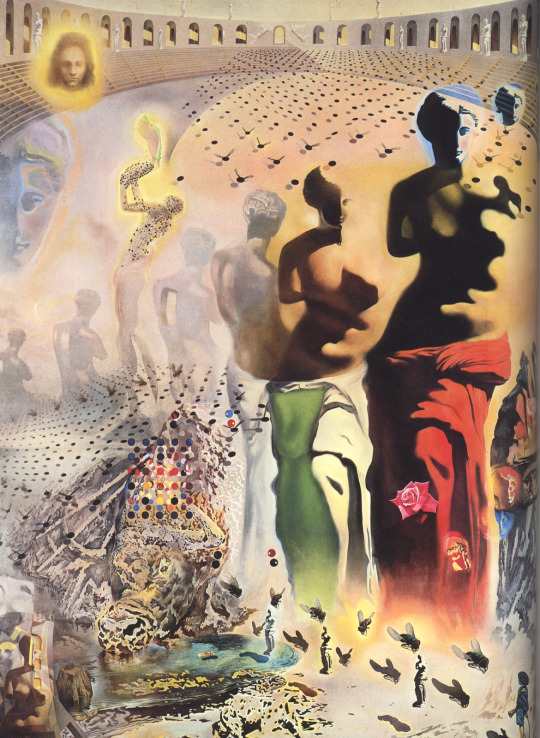
As a fan of Dali, I can see homages in many of his works. The sculpture of Venus de Milo (above), and, the actress Mae West (below), immediately come to mind.
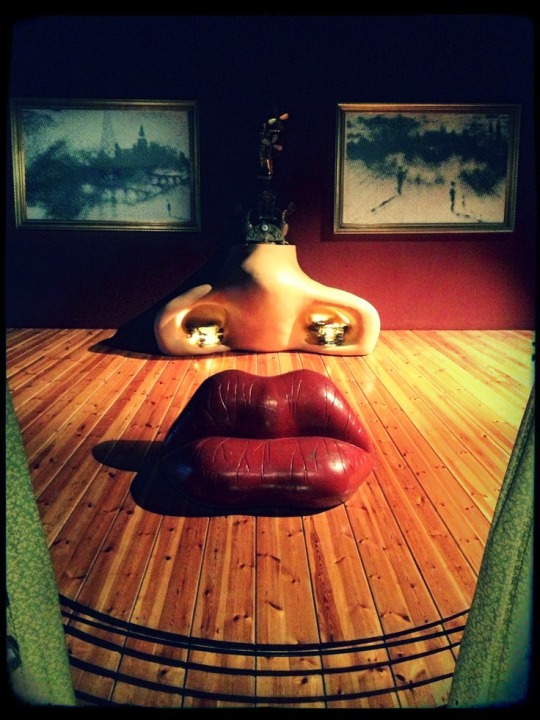
The word “derivative,” as a pejorative, then, is in the eye of the beholder.
Thus, I take the lesson from Dali as authorizing – even mandating – that artists derive their works from forebears.
But, I would speculate that Dali would also disdain works that are dishonest. The distinction is for viewers, and maybe courts, to decide.

DNA: I am somewhat surprised that none of the sources I dug into made any reference to the ultimate “plagiarism” – genetics (above) -
We are physically hardwired facsimiles of not just our mom and pop but moreover the lineage of all our ancestors, ALL OF THEM.
Simultaneously, though, we are all unique.
OK, identical twins have the same DNA, but that is truly a hyperbolic quibble to the point.
Identical twins do not share identical experiences, for one example.
I am reminded of the quote from Heraclitus: “You could not step twice into the same river.”
Thus, we are all possessed of our forebears, and, possessing our individual days under the sun.
A quintessential quote is – apocryphally and ironically attributed to Twain – “History doesn't repeat itself, but it does rhyme.”
And, so it goes, as Kurt Vonnegut used to say.
The rest is silence. I LOVE SHAKESPEARE!
0 notes
Text
#the media you like isn’t representative of your morals, #portraying sensitive subjects doesn’t equal supporting them, #censorship is bad actually, (x)

i will never forgive the internet for making the phrase “fiction affects reality” inherently suspicious because like fiction absolutely does affect reality in the sense that the themes and messages of media can challenge or affirm people’s biases, it can impact one’s ideology, so much of fiction is commentary on real social issues
and yet! everyone who uses the phrase fiction affects reality is using it as a pro-censorship argument and i simply do not fuck with that
8K notes
·
View notes